Film-Forming Microemulsions with Essential Oils: Elucidating Relationships Between Formulation Parameters, Thermodynamic Stability, and Quality Attributes
Abstract
1. Introduction
2. Materials and Methods
2.1. Materials
2.2. Methods
2.2.1. Formulation, Preparation, and Phase Behavior of Ternary and Pseudo-Ternary Mixtures
2.2.2. Formulation, Preparation, and Phase Behavior of Microemulsion Concentrates
2.2.3. Formulation and Preparation of Film-Forming Microemulsions
2.2.4. Physicochemical Characterization of Microemulsion Concentrates and Film-Forming Microemulsions
2.2.5. Examination of the Properties of Films
3. Results and Discussion
3.1. Phase Behavior of Ternary and Pseudo-Ternary Mixtures and Screening of Microemulsion Concentrates
3.2. Phase Behavior of Microemulsion Concentrates with Essential Oils
3.3. Physicochemical Characteristics of Microemulsion Concentrates and Film-Forming Microemulsions with Essential Oils
3.3.1. Flow Behavior and Viscosity of Microemulsion Concentrates and Film-Forming Microemulsions with Essential Oils
3.3.2. pH of Microemulsion Concentrates and Film-Forming Microemulsions with Essential Oils
3.4. Characteristics of Films Obtained from Film-Forming Microemulsions with Essential Oils
4. Conclusions
Supplementary Materials
Author Contributions
Funding
Data Availability Statement
Acknowledgments
Conflicts of Interest
Abbreviations
| IPM | Isopropyl myristate |
| %T | Transmittance |
| 1Φ | Single-phase system |
| 2Φ | Two-phase system |
| 3Φ | Three-phase system |
| cmc | Critical micellar concentration |
| FFM | Film-forming microemulsion |
| FFMw | Weight of the film-forming microemulsion with essential oil |
| Fw | Weight of the dried film |
| HLB | Hydrophilic-lipophilic-balance |
| Km | Surfactant-to-cosurfactant mass ratio |
| MC | Microemulsion concentrate |
| MCT | Medium-chain triglycerides |
| Md | Mass of the separated medium |
| Mw | Molecular weight |
| PCS | Photon correlation spectroscopy |
| PdI | Polydispersity index |
| S (% w/w) | Weight percentage of the swollen film |
| S.D. | Standard deviation |
| Y (% w/w) | Yield |
| Z-ave | Average droplet size |
| η | Absolute viscosity |
| ηapp | Apparent viscosity |
References
- Bakkali, F.; Averbeck, S.; Averbeck, D.; Idaomar, M. Biological Effects of Essential Oils—A Review. Food Chem. Toxicol. 2008, 46, 446–475. [Google Scholar] [CrossRef]
- Burt, S. Essential Oils: Their Antibacterial Properties and Potential Applications in Foods—A Review. Int. J. Food Microbiol. 2004, 94, 223–253. [Google Scholar] [CrossRef] [PubMed]
- Sharmeen, J.B.; Mahomoodally, F.M.; Zengin, G.; Maggi, F. Essential Oils as Natural Sources of Fragrance Compounds for Cosmetics and Cosmeceuticals. Molecules 2021, 26, 666. [Google Scholar] [CrossRef] [PubMed]
- Miguel, M.G. Antioxidant and Anti-Inflammatory Activities of Essential Oils: A Short Review. Molecules 2010, 15, 9252–9287. [Google Scholar] [CrossRef] [PubMed]
- Nuță, D.C.; Limban, C.; Chiriță, C.; Chifiriuc, M.C.; Costea, T.; Ioniță, P.; Nicolau, I.; Zarafu, I. Contribution of Essential Oils to the Fight against Microbial Biofilms—A Review. Processes 2021, 9, 537. [Google Scholar] [CrossRef]
- Shaaban, H.A.E.; El-Ghorab, A.H.; Shibamoto, T. Bioactivity of Essential Oils and Their Volatile Aroma Components: Review. J. Essent. Oil Res. 2012, 24, 203–212. [Google Scholar] [CrossRef]
- Sieniawska, E.; Trifan, A.; Greige-Gerges, H. Special Issue: Isolation and Utilization of Essential Oils: As Antimicrobials and Boosters of Antimicrobial Drug Activity. Processes 2022, 10, 309. [Google Scholar] [CrossRef]
- Turek, C.; Stintzing, F.C. Stability of Essential Oils: A Review. Compr. Rev. Food Sci. Food Saf. 2013, 12, 40–53. [Google Scholar] [CrossRef]
- Almasi, L.; Radi, M.; Amiri, S.; McClements, D.J. Fabrication and Characterization of Antimicrobial Biopolymer Films Containing Essential Oil-Loaded Microemulsions or Nanoemulsions. Food Hydrocoll. 2021, 117, 106733. [Google Scholar] [CrossRef]
- Lee, S.H.; Chow, P.S.; Yagnik, C.K. Developing Eco-Friendly Skin Care Formulations with Microemulsions of Essential Oil. Cosmetics 2022, 9, 30. [Google Scholar] [CrossRef]
- Thakur, D.; Kaur, G.; Puri, A.; Nanda, R. Therapeutic Potential of Essential Oil-Based Microemulsions: Reviewing State-of-the-Art. Curr. Drug Deliv. 2021, 18, 1218–1233. [Google Scholar] [CrossRef] [PubMed]
- Wang, W.; Chen, Y.-F.; Wei, Z.-F.; Jiang, J.-J.; Peng, J.-Q.; He, Q.-T.; Xu, W.-Y.; Liu, H.-M. Microemulsion of Cinnamon Essential Oil Formulated with Tea Polyphenols, Gallic Acid, and Tween 80: Antimicrobial Properties, Stability and Mechanism of Action. Microorganisms 2023, 11, 2. [Google Scholar] [CrossRef]
- Djekic, L. Computer-Aided Formulation Development of Microemulsion Drug Delivery Systems. In Computer-Aided Applications in Pharmaceutical Technology, 2nd ed.; Djuris, J., Ed.; Woodhead Publishing: Sawston, UK, 2024; pp. 41–59. ISBN 978-0-443-18655-4. [Google Scholar]
- Mcclements, D. Nanoemulsions versus Microemulsions: Terminology, Differences, and Similarities. Soft Matter 2012, 8, 1719–1729. [Google Scholar] [CrossRef]
- Chaiyana, W.; Anuchapreeda, S.; Leelapornpisid, P.; Phongpradist, R.; Viernstein, H.; Mueller, M. Development of Microemulsion Delivery System of Essential oil from Zingiber cassumunar Roxb. Rhizome for Improvement of Stability and Anti-Inflammatory Activity. AAPS PharmSciTech 2017, 18, 1332–1342. [Google Scholar] [CrossRef]
- Costa, R.; Santos, L. Delivery Systems for Cosmetics—From Manufacturing to the Skin of Natural Antioxidants. Powder Technol. 2017, 322, 402–416. [Google Scholar] [CrossRef]
- Das, S.; Lee, S.H.; Chow, P.S.; Macbeath, C. Microemulsion Composed of Combination of Skin Beneficial Oils as Vehicle: Development of Resveratrol-Loaded Microemulsion Based Formulations for Skin Care Applications. Colloids Surf. B Biointerfaces 2020, 194, 111161. [Google Scholar] [CrossRef]
- Manzoor, A.; Asif, M.; Khalid, S.H.; Ullah Khan, I.; Asghar, S. Nanosizing of Lavender, Basil, and Clove Essential Oils into Microemulsions for Enhanced Antioxidant Potential and Antibacterial and Antibiofilm Activities. ACS Omega 2023, 8, 40600–40612. [Google Scholar] [CrossRef]
- Bisht, A.; Hemrajani, C.; Rathore, C.; Dhiman, T.; Rolta, R.; Upadhyay, N.; Nidhi, P.; Gupta, G.; Dua, K.; Chellappan, D.K.; et al. Hydrogel Composite Containing Azelaic Acid and Tea Tree Essential Oil as a Therapeutic Strategy for Propionibacterium and Testosterone-Induced Acne. Drug Deliv. Transl. Res. 2022, 12, 2501–2517. [Google Scholar] [CrossRef]
- Catanzano, O.; Straccia, M.C.; Miro, A.; Ungaro, F.; Romano, I.; Mazzarella, G.; Santagata, G.; Quaglia, F.; Laurienzo, P.; Malinconico, M. Spray-by-Spray in Situ Cross-Linking Alginate Hydrogels Delivering a Tea Tree Oil Microemulsion. Eur. J. Pharm. Sci. 2015, 66, 20–28. [Google Scholar] [CrossRef]
- Gheorghita, D.; Grosu, E.; Robu, A.; Ditu, L.M.; Deleanu, I.M.; Gradisteanu Pircalabioru, G.; Raiciu, A.-D.; Bita, A.-I.; Antoniac, A.; Antoniac, V.I. Essential Oils as Antimicrobial Active Substances in Wound Dressings. Materials 2022, 15, 6923. [Google Scholar] [CrossRef]
- Leanpolchareanchai, J.; Teeranachaideekul, V. Topical Microemulsions: Skin Irritation Potential and Anti-Inflammatory Effects of Herbal Substances. Pharmaceuticals 2023, 16, 999. [Google Scholar] [CrossRef] [PubMed]
- Nguyen, N.N.T.; Nguyen, T.T.D.; Vo, D.L.; Than, D.T.M.; Tien, G.P.; Pham, D.T. Microemulsion-Based Topical Hydrogels Containing Lemongrass Leaf Essential Oil (Cymbopogon Citratus (DC.) Stapf) and Mango Seed Kernel Extract (Mangifera Indica Linn) for Acne Treatment: Preparation and in-Vitro Evaluations. PLoS ONE 2024, 19, e0312841. [Google Scholar] [CrossRef]
- Pansang, S.; Maphanta, S.; Tuntijarukorn, P.; Viyoch, J. Skin Irritation Test of a Microemulsion Containing Essential Oil Isolated from Ocimum Basilicum. ScienceAsia 2010, 36, 355–358. [Google Scholar] [CrossRef]
- Prommaban, A.; Chaiyana, W. Microemulsion of Essential Oils from Citrus Peels and Leaves with Anti-Aging, Whitening, and Irritation Reducing Capacity. J. Drug Deliv. Sci. Technol. 2022, 69, 103188. [Google Scholar] [CrossRef]
- Sieniawska, E.; Wota, M.; Mroczek, T. Microemulsions of Essential Oils—An Improvement of Solubility or Something More? Facta Univ. Ser. Phys. Chem. Technol. 2018, 16, 47. [Google Scholar]
- Sutthisawatkul, P.; Piyanaetitham, P.; Chareonviriyaphap, T.; Leepasert, T.; Taengphan, W.; Karpkird, T. Microemulsion Containing Guava Leaves Essential Oil: Enhanced Anti-Inflammatory, Anti-Oxidation, Anti-Tyrosinase Activities and Skin Permeation. J. Drug Deliv. Sci. Technol. 2024, 95, 105536. [Google Scholar] [CrossRef]
- Lv, X.; Liu, T.; Ma, H.; Tian, Y.; Li, L.; Li, Z.; Gao, M.; Zhang, J.; Tang, Z. Preparation of Essential Oil-Based Microemulsions for Improving the Solubility, pH Stability, Photostability, and Skin Permeation of Quercetin. AAPS PharmSciTech 2017, 18, 3097–3104. [Google Scholar] [CrossRef]
- Sakr, F.M.; Gado, A.M.; Mohammed, H.R.; Adam, A.N.I. Preparation and Evaluation of a Multimodal Minoxidil Microemulsion versus Minoxidil Alone in the Treatment of Androgenic Alopecia of Mixed Etiology: A Pilot Study. Drug Des. Devel. Ther. 2013, 7, 413–423. [Google Scholar] [CrossRef]
- Khalid, S.; Kok-Khiang, P. Identification of Phases of Various Oil, Surfactant/Co-Surfactants and Water System by Ternary Phase Diagram. Acta Pol. Pharm. 2014, 71, 301–309. [Google Scholar]
- Chen, J.; Ma, X.; Yao, G.; Zhang, W.; Zhao, Y. Microemulsion-Based Anthocyanin Systems: Effect of Surfactants, Cosurfactants, and Its Stability. Int. J. Food Prop. 2018, 21, 1152–1165. [Google Scholar] [CrossRef]
- Gull, A.; Ahmed, S.; Ahmad, F.J.; Nagaich, U.; Chandra, A. Hydrogel Thickened Microemulsion; a Local Cargo for the Co- Delivery of Cinnamaldehyde and Berberine to Treat Acne Vulgaris. J. Drug Deliv. Sci. Technol. 2020, 58, 101835. [Google Scholar] [CrossRef]
- Blanco, G.E.O.D.; De Souza, C.W.O.; Bernardo, M.P.; Zenke, M.; Mattoso, L.H.C.; Moreira, F.K.V. Antimicrobially Active Gelatin/[Mg-Al-CO3]-LDH Composite Films Based on Clove Essential Oil for Skin Wound Healing. Mater. Today Commun. 2021, 27, 102169. [Google Scholar] [CrossRef]
- Hota, S.S.; Nandi, S.; Mallick, S. Effect of Surfactant on Hydration and Stress-Strain of Hypromellose Film Formation. Rev. Cuba. Farm. 2022, 55, e786. [Google Scholar]
- Milinković, S.; Djekić, L. Hypromellose-Based Films and Film-Forming Systems for Topical Application: Current Status and Perspective in Drug Delivery. Arch. Pharm. 2024, 74, 709–734. [Google Scholar] [CrossRef]
- European Pharmacopeia, 11th ed.; Directorate for the Quality of Medicines & HealthCare of the Council of Europe (EDQM), Council of Europe: Strasbourg, France, 2022.
- Sheskey, P.J.; Cook, W.G.; Cable, C.G. Handbook of Pharmaceutical Excipients, 9th ed.; Pharmaceutical Press: London, UK; Chicago, IL, USA, 2020. [Google Scholar]
- Tundisi, L.L.; Mostaço, G.B.; Carricondo, P.C.; Petri, D.F.S. Hydroxypropyl Methylcellulose: Physicochemical Properties and Ocular Drug Delivery Formulations. Eur. J. Pharm. Sci. 2021, 159, 105736. [Google Scholar] [CrossRef]
- Mašková, E.; Kubová, K.; Raimi-Abraham, B.T.; Vllasaliu, D.; Vohlídalová, E.; Turánek, J.; Mašek, J. Hypromellose—A Traditional Pharmaceutical Excipient with Modern Applications in Oral and Oromucosal Drug Delivery. J. Control. Release 2020, 324, 695–727. [Google Scholar] [CrossRef]
- Saingam, W.; Chankana, N.; Madaka, F.; Sueree, L.; Homchuam, S. Formulation Development of Topical Film Formimg Spray from Piper nigrum L. Thai J. Pharm. Sci. 2018, 42, 219–222. [Google Scholar]
- Zúñiga, R.N.; Skurtys, O.; Osorio, F.; Aguilera, J.M.; Pedreschi, F. Physical Properties of Emulsion-Based Hydroxypropyl Methylcellulose Films: Effect of Their Microstructure. Carbohydr. Polym. 2012, 90, 1147–1158. [Google Scholar] [CrossRef]
- Djekic, L.; Cirkovic, V.; Heleta, M.; Krajisnik, D.; Primorac, M. Water-Dilutable Biocompatible Microemulsion Systems: Design and Characterisation. Tenside Surfactants Deterg. 2013, 50, 409–413. [Google Scholar] [CrossRef]
- Takechi-Haraya, Y.; Ohgita, T.; Demizu, Y.; Saito, H.; Izutsu, K.; Sakai-Kato, K. Current Status and Challenges of Analytical Methods for Evaluation of Size and Surface Modification of Nanoparticle-Based Drug Formulations. AAPS PharmSciTech 2022, 23, 150. [Google Scholar] [CrossRef]
- Djekic, L.; Primorac, M. The Influence of Cosurfactants and Oils on the Formation of Pharmaceutical Microemulsions Based on PEG-8 Caprylic/Capric Glycerides. Int. J. Pharm. 2008, 352, 231–239. [Google Scholar] [CrossRef] [PubMed]
- Kathe, K.; Kathpalia, H. Film Forming Systems for Topical and Transdermal Drug Delivery. Asian J. Pharm. Sci. 2017, 12, 487–497. [Google Scholar] [CrossRef] [PubMed]
- Karki, S.; Kim, H.; Na, S.-J.; Shin, D.; Jo, K.; Lee, J. Thin Films as an Emerging Platform for Drug Delivery. Asian J. Pharm. Sci. 2016, 11, 559–574. [Google Scholar] [CrossRef]
- Shimamura, T.; Tairabune, T.; Kogo, T.; Ueda, H.; Numajiri, S.; Kobayashi, D.; Morimoto, Y. Investigation of the Release Test Method for the Topical Application of Pharmaceutical Preparations: Release Test of Cataplasm Including Nonsteroidal Anti-Inflammatory Drugs Using Artificial Sweat. Chem. Pharm. Bull. 2004, 52, 167–171. [Google Scholar] [CrossRef]
- Djekic, L.; Jankovic, J.; Čalija, B.; Primorac, M. Development of Semisolid Self-Microemulsifying Drug Delivery Systems (SMEDDSs) Filled in Hard Capsules for Oral Delivery of Aciclovir. Int. J. Pharm. 2017, 528, 372–380. [Google Scholar] [CrossRef]
- Pouton, C.W. Formulation of Poorly Water-Soluble Drugs for Oral Administration: Physicochemical and Physiological Issues and the Lipid Formulation Classification System. Eur. J. Pharm. Sci. 2006, 29, 278–287. [Google Scholar] [CrossRef]
- Jadhav, H.B.; Annapure, U.S. Triglycerides of Medium-Chain Fatty Acids: A Concise Review. J. Food Sci. Technol. 2023, 60, 2143–2152. [Google Scholar] [CrossRef]
- PubChem/Isopropyl Myristate. Available online: https://pubchem.ncbi.nlm.nih.gov/compound/Isopropyl-Myristate (accessed on 24 February 2025).
- Musakhanian, J.; Osborne, D.W.; Rodier, J.-D. Skin Penetration and Permeation Properties of Transcutol® in Complex Formulations. AAPS PharmSciTech 2024, 25, 201. [Google Scholar] [CrossRef]
- Kolliphor® RH 40 Technical Information. Available online: https://pharma.basf.com/technicalinformation/30555082/kolliphor-rh-40 (accessed on 24 February 2025).
- Alexandridis, P.; Ivanova, R.; Lindman, B. Effect of Glycols on the Self-Assembly of Amphiphilic Block Copolymers in Water. 2. Glycol Location in the Microstructure. Langmuir 2000, 16, 3676–3689. [Google Scholar] [CrossRef]
- Pouton, C.W.; Porter, C.J.H. Formulation of Lipid-Based Delivery Systems for Oral Administration: Materials, Methods and Strategies. Adv. Drug Deliv. Rev. 2008, 60, 625–637. [Google Scholar] [CrossRef]
- Janković, J.; Djekic, L.; Dobričić, V.; Primorac, M. Evaluation of Critical Formulation Parameters in Design and Differentiation of Self-Microemulsifying Drug Delivery Systems (SMEDDSs) for Oral Delivery of Aciclovir. Int. J. Pharm. 2016, 497, 301–311. [Google Scholar] [CrossRef] [PubMed]
- Djekic, L.; Primorac, M. Microemulsions and Nanoemulsions as Carriers for Delivery of NSAIDs. In Microsized and Nanosized Carriers for Nonsteroidal Anti-Inflammatory Drugs: Formulation Challenges and Potential Benefits; Elsevier: Amsterdam, The Netherlands, 2017; pp. 69–94. ISBN 978-0-12-804017-1. [Google Scholar]
- Spectrum/MCT. Available online: https://www.spectrumchemical.com/medium-chain-triglycerides-nf-m4200 (accessed on 24 February 2025).
- HallstarBeauty IPM. Available online: https://www.hallstarbeauty.com/product/hallstar-ipm-nf/ (accessed on 24 February 2025).
- Spohner, M. Study of Dielectric Properties of Mineral Oils and Natural Oils and Methyl Esters of Natural Oils. In Proceedings of the 2017 IEEE 19th International Conference on Dielectric Liquids (ICDL), Manchester, UK, 25–29 June 2017. [Google Scholar]
- PubChem/Cinnamon Oil. Available online: https://pubchem.ncbi.nlm.nih.gov/compound/Cinnamon%20Oil#section=Decomposition (accessed on 24 February 2025).
- ChemicalBook/Thyme Oil. Available online: https://www.chemicalbook.com/ChemicalProductProperty_EN_CB6739355.htm (accessed on 24 February 2025).
- ChemicalBook/Tea Tree Oil. Available online: https://www.chemicalbook.com/ChemicalProductProperty_EN_CB3125672.htm (accessed on 24 February 2025).
- Bao, K.; Lavrov, A.; Nilsen, H.M. Numerical Modeling of Non-Newtonian Fluid Flow in Fractures and Porous Media. Comput. Geosci. 2017, 21, 1313–1324. [Google Scholar] [CrossRef]
- Mondal, S.; Pyne, P.; Patra, A.; Mitra, R.K.; Ghosh, S. Effect of Surfactant Tail Length on the Hydroxypropyl Cellulose-Mediated Premicellar Aggregation of Sodium n-Alkyl Sulfate Surfactants. Langmuir 2021, 37, 6168–6177. [Google Scholar] [CrossRef] [PubMed]
- Song, K.; Huang, W.; Wan, H.; Huang, H. Development of Shear Thickening Material. IOP Conf. Ser. Mater. Sci. Eng. 2017, 207, 012024. [Google Scholar] [CrossRef]
- Punitha, S.; Uvarani, R.; Panneerselvam, A. Effect of pH in Aqueous (Hydroxy Propyl Methyl Cellulose) Polymer Solution. Results Mater. 2020, 7, 100120. [Google Scholar] [CrossRef]
- Buraczewska, I.; Lodén, M. Treatment of Surfactant-Damaged Skin in Humans with Creams of Different pH Values. Pharmacology 2005, 73, 1–7. [Google Scholar] [CrossRef]
- Umar, A.K.; Butarbutar, M.; Sriwidodo, S.; Wathoni, N. Film-Forming Sprays for Topical Drug Delivery. Drug Des. Devel. Ther. 2020, 14, 2909–2925. [Google Scholar] [CrossRef]
- ChemicalBook/Cinnamon Oil. Available online: https://www.chemicalbook.com/ChemicalProductProperty_EN_CB9437582.htm (accessed on 24 February 2025).
- Ozdemir, O.; Karakashev, S.I.; Nguyen, A.V.; Miller, J.D. Adsorption and Surface Tension Analysis of Concentrated Alkali Halide Brine Solutions. Miner. Eng. 2009, 22, 263–271. [Google Scholar] [CrossRef]
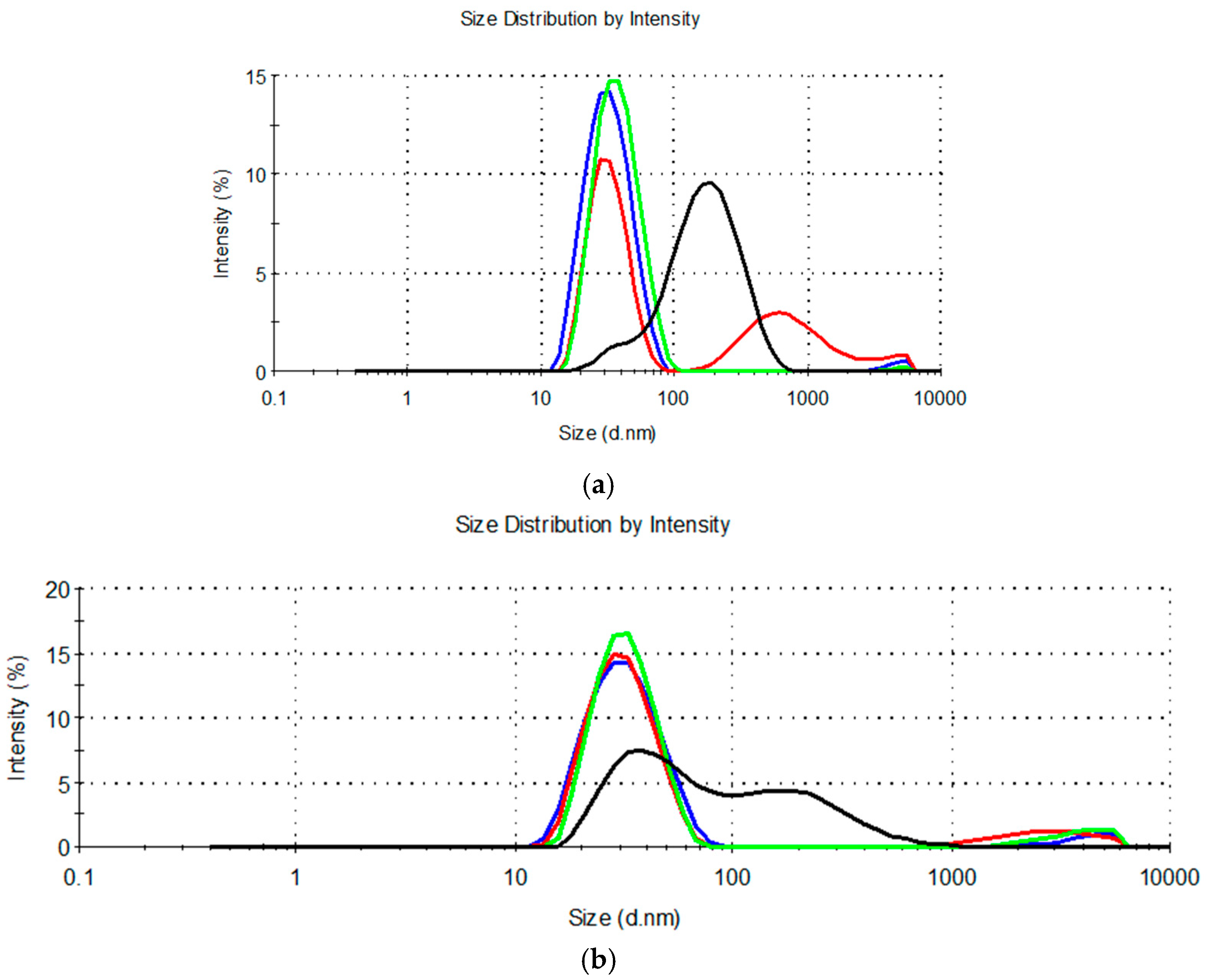
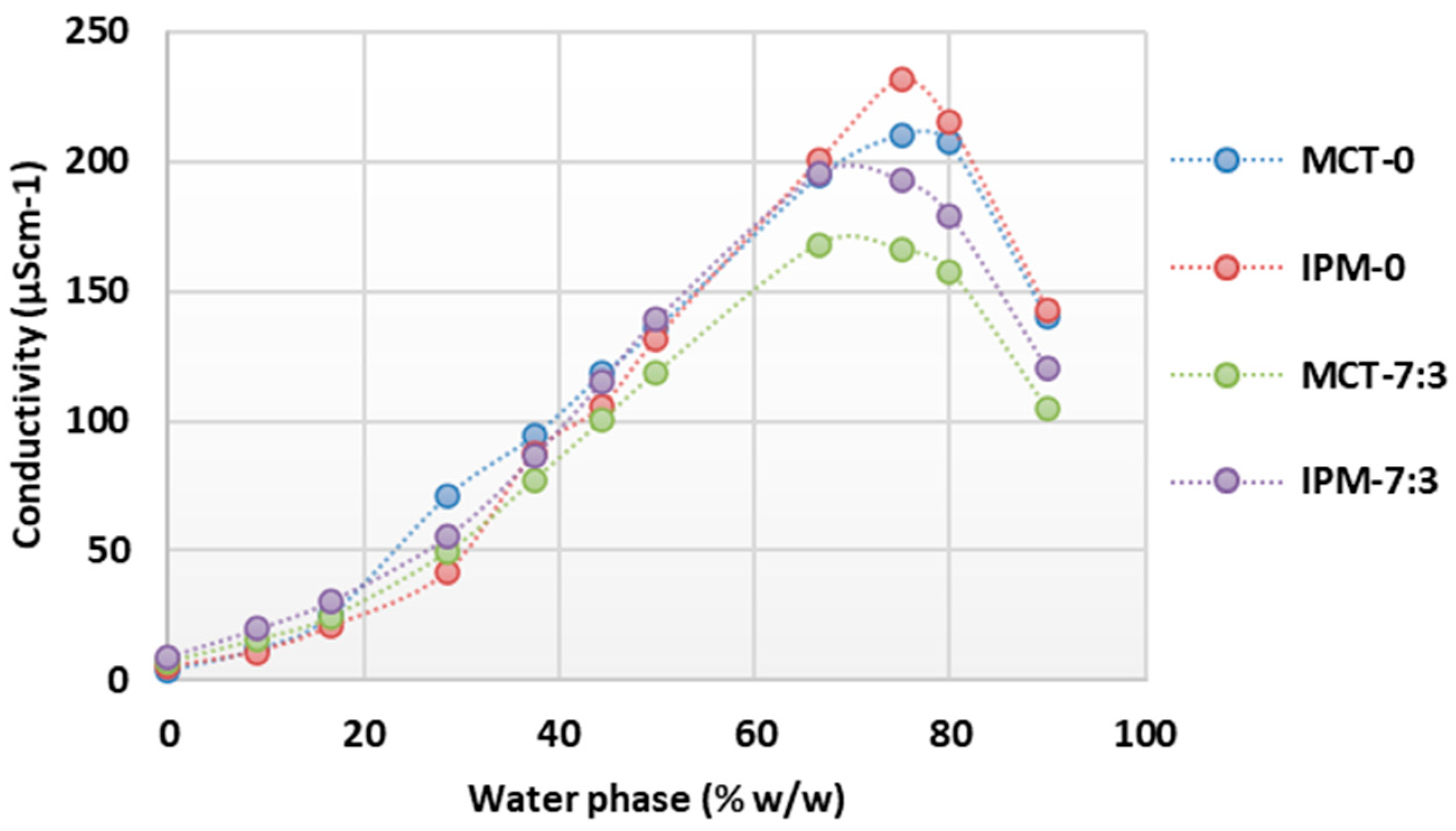


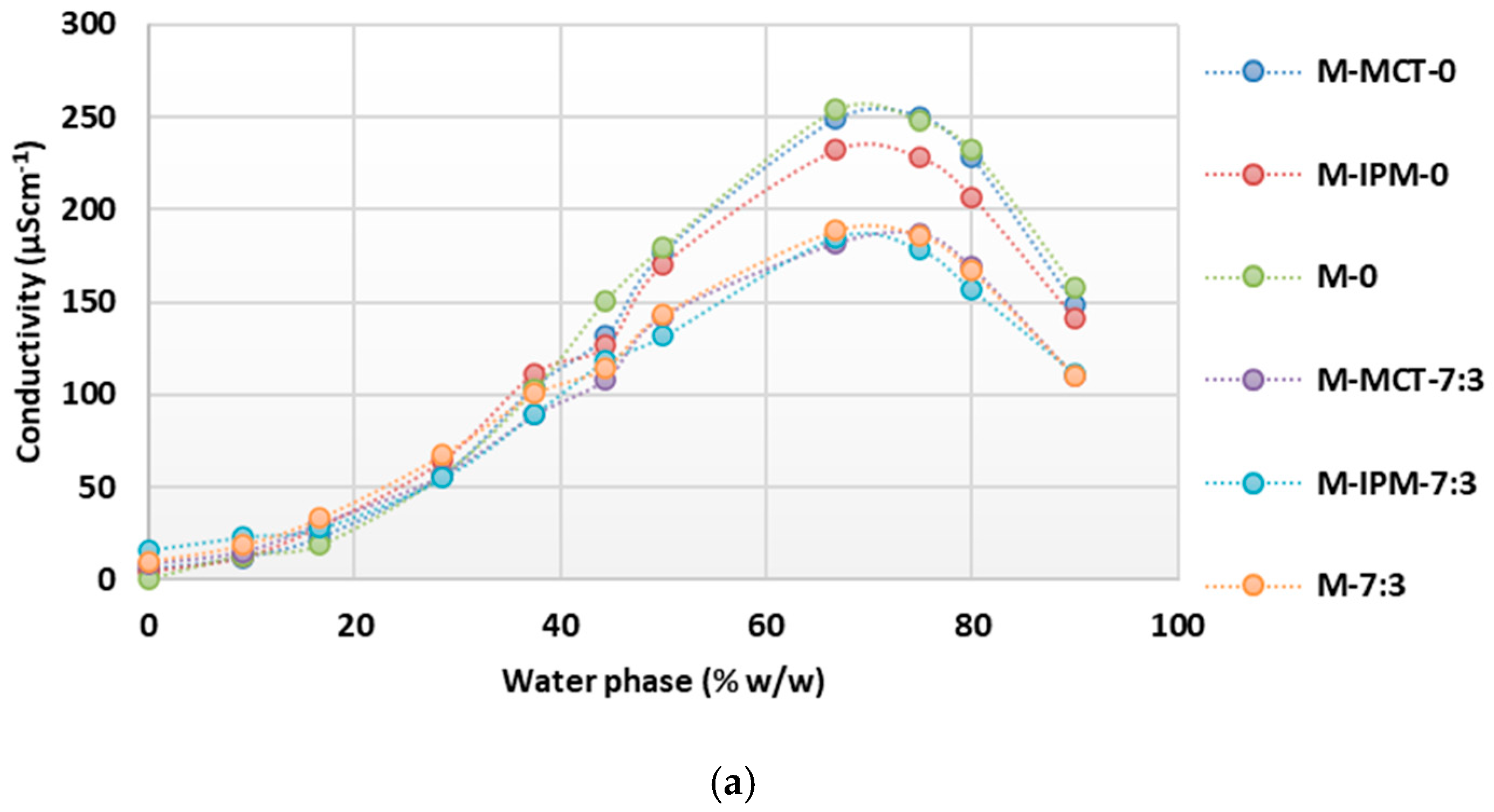

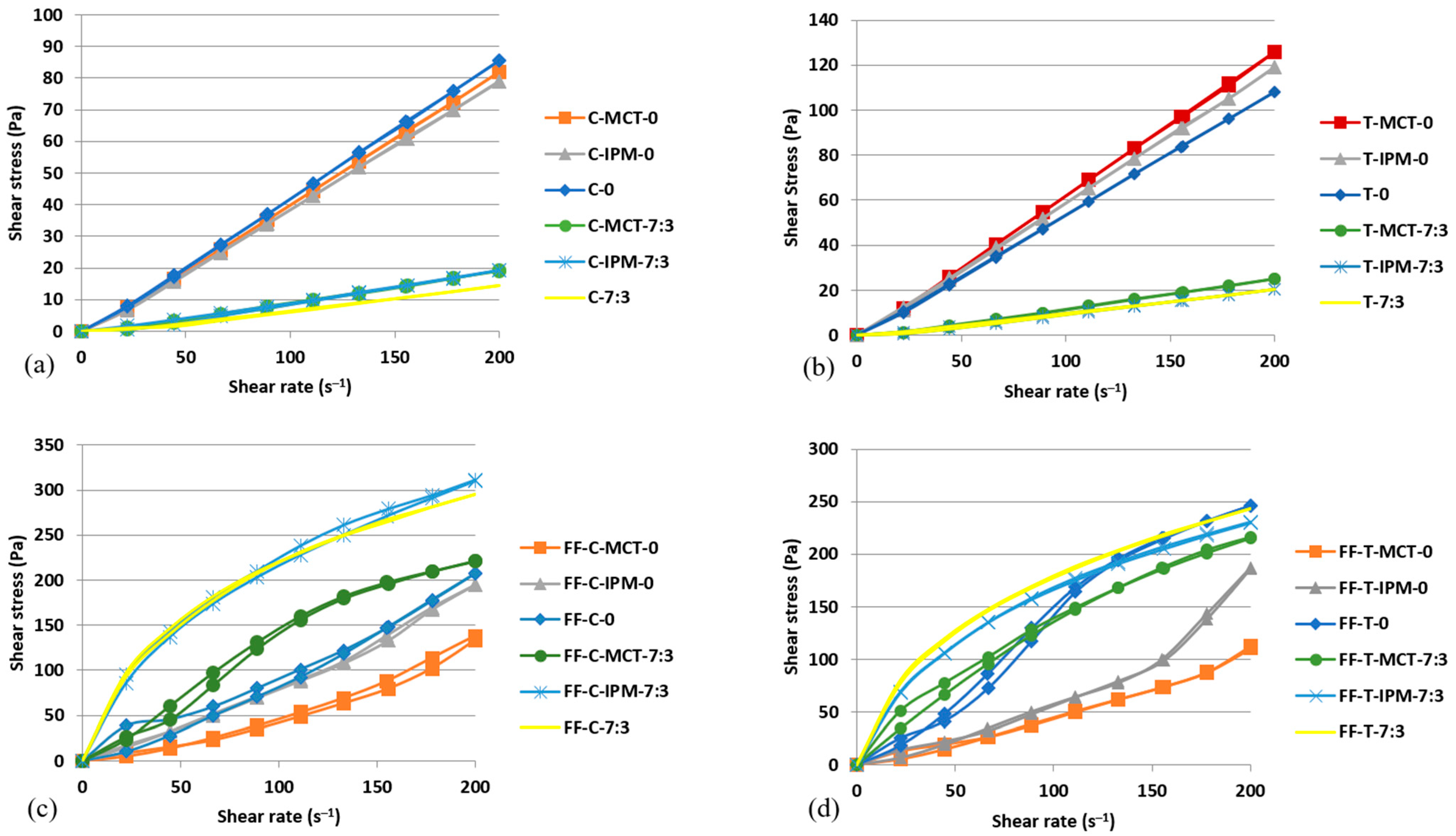

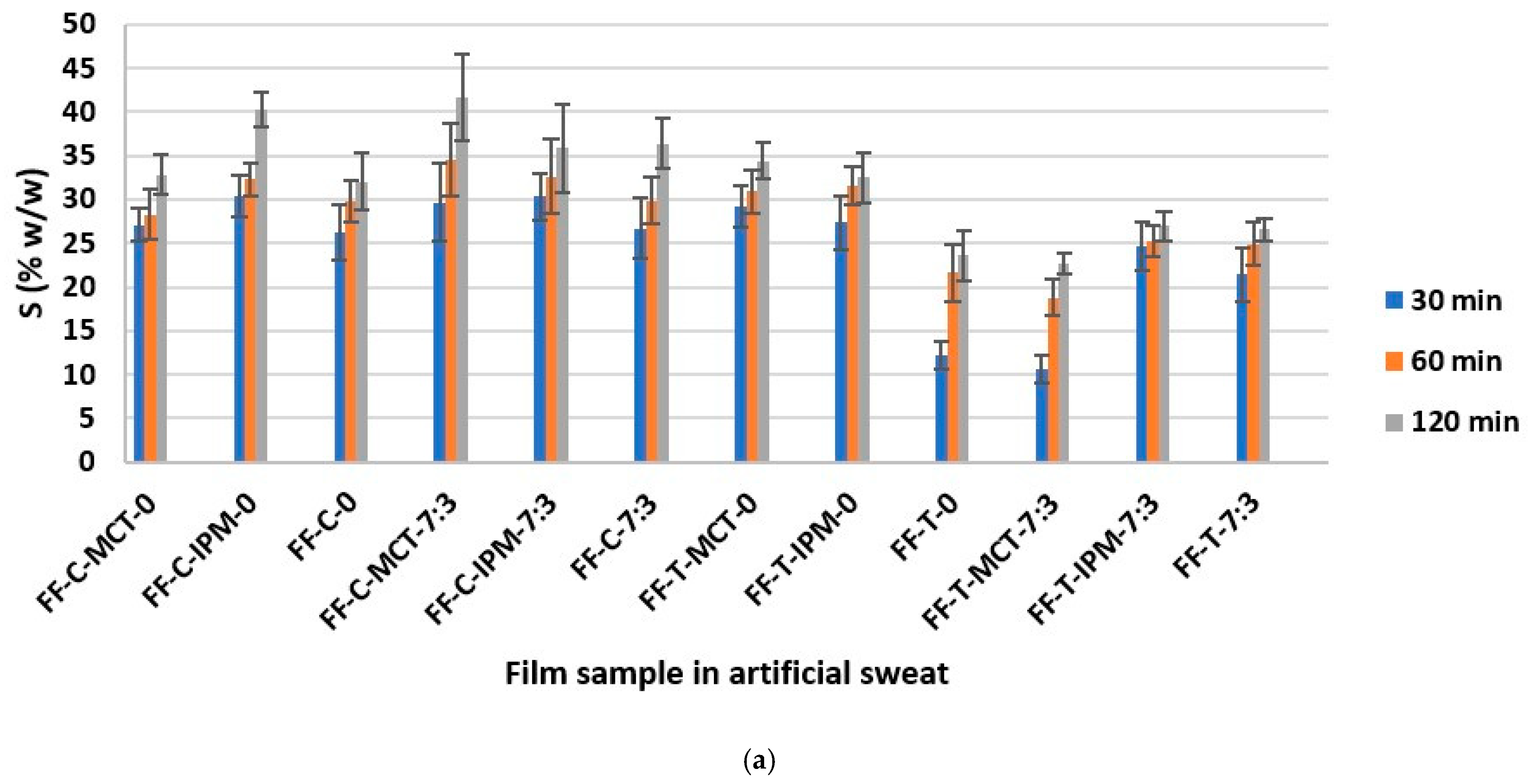
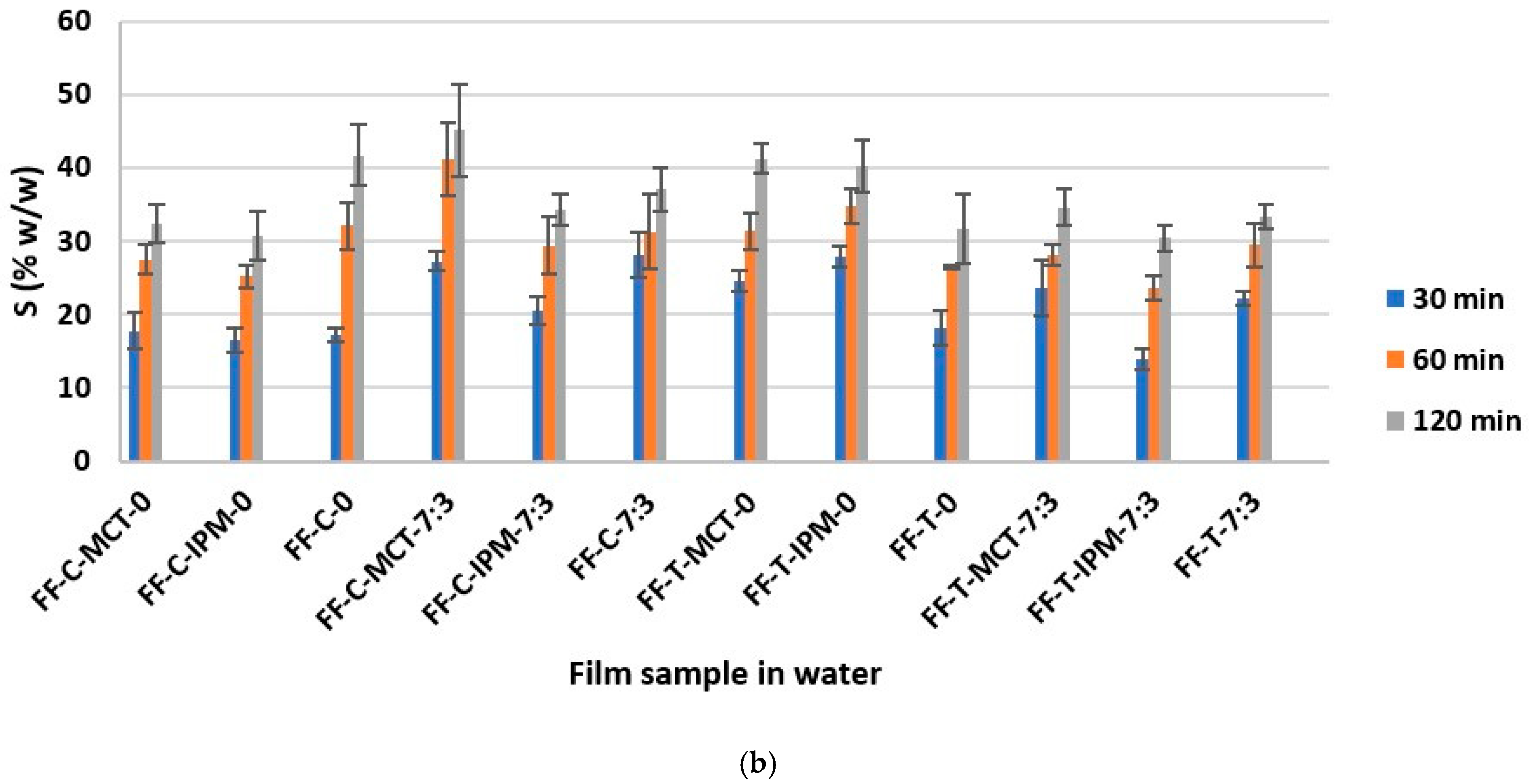
| Oil (% w/w) a | Surfactant (% w/w) b | Cosurfactant (% w/w) c | Cosolvent (% w/w) d |
|---|---|---|---|
| 10.00 | 70.00 | / | 20.00 |
| 10.00 | 63.00 | 7.00 | 20.00 |
| 10.00 | 49.00 | 21.00 | 20.00 |
| 10.00 | 35.00 | 35.00 | 20.00 |
| Sample | %T (%) | Z-ave ± S.D. (nm) | PdI ± S.D. |
|---|---|---|---|
| MCT-0 | 96.93 | 30.26 ± 0.08 | 0.170 ± 0.018 |
| MCT-9:1 | 79.96 | Multimodal distribution | / |
| MCT-7:3 | 95.75 | 35.13 ± 0.07 | 0.145 ± 0.008 |
| MCT-1:1 | 72.99 | 133 ± 0.61 | 0.280 ± 0.010 |
| IPM-0 | 95.70 | 30.86 ± 0.06 | 0.204 ± 0.06 |
| IPM-9:1 | 96.42 | 32.21 ± 0.06 | 0.255 ± 0.006 |
| IPM-7:3 | 96.00 | 33.01 ± 0.89 | 0.232 ± 0.019 |
| IPM-1:1 | 76.59 | 60.79 ± 14.42 | 0.368 ± 0.038 |
| Sample | Synthetic Oil (% w/w) | Essential Oil (% w/w) | Surfactant (% w/w) | Cosurfactant (% w/w) | Cosolvent (% w/w) |
|---|---|---|---|---|---|
| M-MCT-0 | 5.00 | 5.00 | 70.00 | / | 20.00 |
| M-IPM-0 | 5.00 | 5.00 | 70.00 | / | 20.00 |
| M-0 | / | 10.00 | 70.00 | / | 20.00 |
| M-MCT-7:3 | 5.00 | 5.00 | 49.00 | 21.00 | 20.00 |
| M-IPM-7:3 | 5.00 | 5.00 | 49.00 | 21.00 | 20.00 |
| M-7:3 | / | 10.00 | 49.00 | 21.00 | 20.00 |
| T-MCT-0 | 5.00 | 5.00 | 70.00 | / | 20.00 |
| T-IPM-0 | 5.00 | 5.00 | 70.00 | / | 20.00 |
| T-0 | / | 10.00 | 70.00 | / | 20.00 |
| T-MCT-7:3 | 5.00 | 5.00 | 49.00 | 21.00 | 20.00 |
| T-IPM-7:3 | 5.00 | 5.00 | 49.00 | 21.00 | 20.00 |
| T-7:3 | / | 10.00 | 49.00 | 21.00 | 20.00 |
| C-MCT-0 | 5.00 | 5.00 | 70.00 | / | 20.00 |
| C-IPM-0 | 5.00 | 5.00 | 70.00 | / | 20.00 |
| C-0 | / | 10.00 | 70.00 | / | 20.00 |
| C-MCT-7:3 | 5.00 | 5.00 | 49.00 | 21.00 | 20.00 |
| C-IPM-7:3 | 5.00 | 5.00 | 49.00 | 21.00 | 20.00 |
| C-7:3 | / | 10.00 | 49.00 | 21.00 | 20.00 |
| Sample | %T (%) | Z-ave ± S.D. (nm) | PdI ± S.D. |
|---|---|---|---|
| M-MCT | 98.45 | 25.63 ± 0.21 | 0.09 ± 0.01 |
| M-IPM | 98.25 | 25.61 ± 0.21 | 0.08 ± 0.00 |
| M-0 | 98.77 | 23.93 ± 0.12 | 0.06 ± 0.01 |
| M-MCT-7:3 | 98.90 | 27.21 ± 0.23 | 0.06 ± 0.01 |
| M-IPM-7:3 | 98.53 | 27.20 ± 0.27 | 0.07 ± 0.01 |
| M-7:3 | 98.69 | 24.81 ± 0.20 | 0.06 ± 0.01 |
| C-MCT | 93.49 | 15.69 ± 0.41 | 0.132 ± 0.052 |
| C-IPM | 95.80 | 15.07 ± 0.49 | 0.105 ± 0.010 |
| C-0 | 91.89 | 13.07 ± 0.48 | 0.060 ± 0.003 |
| C-MCT-7:3 | 98.01 | 16.72 ± 0.93 | 0.148 ± 0.029 |
| C-IPM-7:3 | 94.94 | 16.51 ± 0,74 | 0.138 ± 0.015 |
| C-7:3 | 93.25 | 15.07 ± 0.13 | 0.082 ± 0.014 |
| T-MCT | 99.04 | 15.75 ± 0.63 | 0.061 ± 0.0004 |
| T-IPM | 98.42 | 15.51 ± 0.57 | 0.053 ± 0.012 |
| T-0 | 96.03 | 14.55 ± 0.17 | 0.043 ± 0.014 |
| T-MCT-7:3 | 98.78 | 17.18 ± 0.47 | 0.094 ± 0.010 |
| T-IPM-7:3 | 99.36 | 17.20 ± 0.67 | 0.086 ± 0.017 |
| T-7:3 | 97.59 | 15.85 ± 0.54 | 0.047 ± 0.006 |
| MC | η ± S.D. (mPa·s) | MC | η ± S.D. (mPa·s) | FFM | ηapp ± S.D. @ 22.2 s−1 (mPa·s) | ηapp ± S.D. @ 200 s−1 (mPa·s) | FFM | ηapp ± S.D. @ 22.2 s−1 (mPa·s) | ηapp ± S.D. @ 200 s−1 (mPa·s) |
|---|---|---|---|---|---|---|---|---|---|
| C-MCT | 384 ± 12 | T-MCT | 605 ± 18 | FF-C-MCT | 389 ± 8 | 667 ± 13 | FF-T-MCT | 551 ± 8 | 577 ± 8 |
| C-IPM | 373 ± 6 | T-IPM | 577 ± 9 | FF-C-IPM | 585 ± 7 | 1011 ± 12 | FF-T-IPM | 628 ± 7 | 929 ± 10 |
| C-0 | 408 ± 12 | T-0 | 521 ± 16 | FF-C-0 | 1105 ± 18 | 1187 ± 19 | FF-T-0 | 477 ± 10 | 524 ± 11 |
| C-MCT-7:3 | 56.2 ± 1.0 | T-MCT-7:3 | 86.9 ± 1.5 | FF-C-MCT-7:3 | 1740 ± 40 | 1030 ± 24 | FF-T-MCT-7:3 | 2300 ± 69 | 1080 ± 32 |
| C-IPM-7:3 | 59.0 ± 1.1 | T-IPM-7:3 | 59.7 ± 1.1 | FF-C-IPM-7:3 | 4300 ± 56 | 1550 ± 20 | FF-T-IPM-7:3 | 3075 ± 43 | 1155 ± 16 |
| C-7:3 | 49.1 ± 0.6 | T-7:3 | 64.7 ± 0.8 | FF-C-7:3 | 4370 ± 39 | 1470 ± 13 | FF-T-7:3 | 3475 ± 56 | 1215 ± 19 |
| MC | pH | FFM | pH | MC | pH | FFM | pH |
|---|---|---|---|---|---|---|---|
| C-MCT | 4.72 | FF-C-MCT | 5.73 | T-MCT | 5.57 | FF-T-MCT | 6.60 |
| C-IPM | 4.72 | FF-C-IPM | 5.67 | T-IPM | 5.56 | FF-T-IPM | 6.70 |
| C-0 | 4.38 | FF-C-0 | 5.26 | T-0 | 5.56 | FF-T-0 | 6.81 |
| C-MCT-7:3 | 4.00 | FF-C-MCT-7:3 | 5.04 | T-MCT-7:3 | 4.32 | FF-T-MCT-7:3 | 5.43 |
| C-IPM-7:3 | 4.00 | FF-C-IPM-7:3 | 5.04 | T-IPM-7:3 | 4.26 | FF-T-IPM-7:3 | 5.46 |
| C-7:3 | 3.82 | FF-C-7:3 | 4.87 | T-7:3 | 4.30 | FF-T-7:3 | 5.57 |
| Sample | FW ± S.D. (g) | Y ± S.D. (% w/w) | Sample | FW ± S.D. (g) | Y ± S.D. (% w/w) |
|---|---|---|---|---|---|
| FF-C-MCT | 0.55 ± 0.06 | 11.00 ± 1.10 | FF-T-MCT | 0.53 ± 0.04 | 10.60 ± 0.74 |
| FF-C-IPM | 0.52 ± 0.04 | 10.40 ± 0.83 | FF-T-IPM | 0.50 ± 0.05 | 10.00 ± 1.00 |
| FF-C-0 | 0.49 ± 0.05 | 9.80 ± 1.08 | FF-T-0 | 0.49 ± 0.06 | 9.80 ± 1.18 |
| FF-C-MCT-7:3 | 0.45 ± 0.05 | 9.00 ± 0.90 | FF-T-MCT-7:3 | 0.40 ± 0.04 | 8.00 ± 0.72 |
| FF-C-IPM-7:3 | 0.43 ± 0.04 | 8.60 ± 0.86 | FF-T-IPM-7:3 | 0.39 ± 0.05 | 7.80 ± 0.94 |
| FF-C-7:3 | 0.43 ± 0.05 | 8.60 ± 1.03 | FF-T-7:3 | 0.38 ± 0.03 | 7.60 ± 0.61 |
Disclaimer/Publisher’s Note: The statements, opinions and data contained in all publications are solely those of the individual author(s) and contributor(s) and not of MDPI and/or the editor(s). MDPI and/or the editor(s) disclaim responsibility for any injury to people or property resulting from any ideas, methods, instructions or products referred to in the content. |
© 2025 by the authors. Licensee MDPI, Basel, Switzerland. This article is an open access article distributed under the terms and conditions of the Creative Commons Attribution (CC BY) license (https://creativecommons.org/licenses/by/4.0/).
Share and Cite
Đekić, L.; Ćirić, A.; Milinković, S.; Budinčić, J.M.; Fraj, J.; Petrović, L. Film-Forming Microemulsions with Essential Oils: Elucidating Relationships Between Formulation Parameters, Thermodynamic Stability, and Quality Attributes. Processes 2025, 13, 990. https://doi.org/10.3390/pr13040990
Đekić L, Ćirić A, Milinković S, Budinčić JM, Fraj J, Petrović L. Film-Forming Microemulsions with Essential Oils: Elucidating Relationships Between Formulation Parameters, Thermodynamic Stability, and Quality Attributes. Processes. 2025; 13(4):990. https://doi.org/10.3390/pr13040990
Chicago/Turabian StyleĐekić, Ljiljana, Ana Ćirić, Sandra Milinković, Jelena Milinković Budinčić, Jadranka Fraj, and Lidija Petrović. 2025. "Film-Forming Microemulsions with Essential Oils: Elucidating Relationships Between Formulation Parameters, Thermodynamic Stability, and Quality Attributes" Processes 13, no. 4: 990. https://doi.org/10.3390/pr13040990
APA StyleĐekić, L., Ćirić, A., Milinković, S., Budinčić, J. M., Fraj, J., & Petrović, L. (2025). Film-Forming Microemulsions with Essential Oils: Elucidating Relationships Between Formulation Parameters, Thermodynamic Stability, and Quality Attributes. Processes, 13(4), 990. https://doi.org/10.3390/pr13040990






